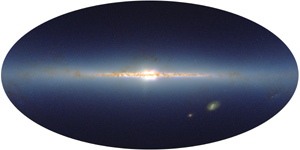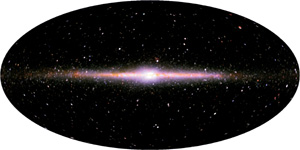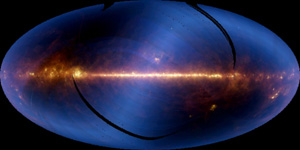



|
Palomar Observatory Sky Survey (POSS) The first version of this visible light (wavelengths: 0.4 - 0.65 microns) sky survey was carried out in the 1950s on Mount Palomar in San Diego, California. In the 1970s the U.K. Schmidt telescope surveyed the southern sky in an identical fashion as the Palomar telescope. The data, which were orginally taken as photographic plates, are now combined together in the Digitized Sky Survey. Two Micron All-Sky Survey (2MASS) 2MASS is also an all-sky survey carried out with ground-based telescopes (one in Arizona and one in Chile). This survey studied the sky in near-infrared light (wavelenths: 1.25 - 2.17 microns), fully mapping the Milky Way and nearby Universe.
Cosmic Background Explorer (COBE) COBE was a NASA satellite mission that mapped the entire sky in infrared and microwave wavelengths. One of the instruments aboard, DIRBE, surveyed the sky in the near-infrared (wavelengths: 1.25 - 3.5 microns).
Infrared Astronomical Satellite (IRAS) IRAS was a NASA satellite mission in the 1980s that studied the Universe in the infrared. It conducted an all-sky survey in the infrared (wavelengths: 12 - 100 microns). :: IRAS at the Infrared Processing and Analysis Center (IPAC)
|
|
|||


